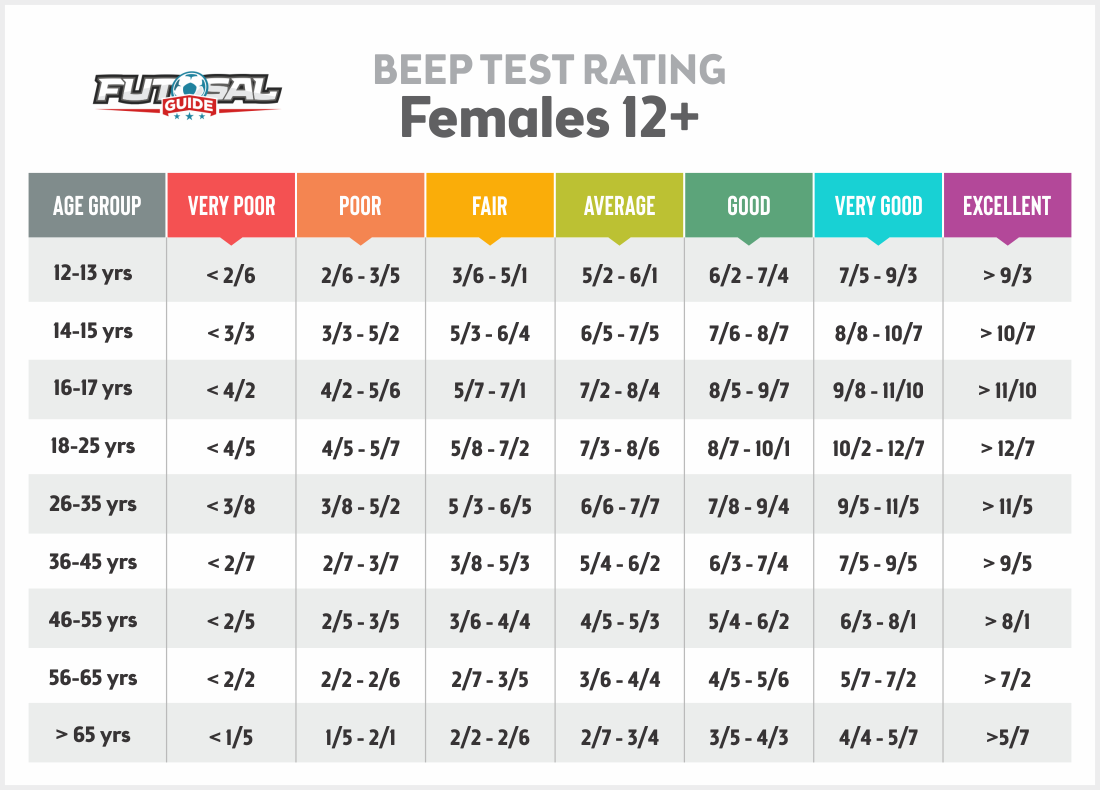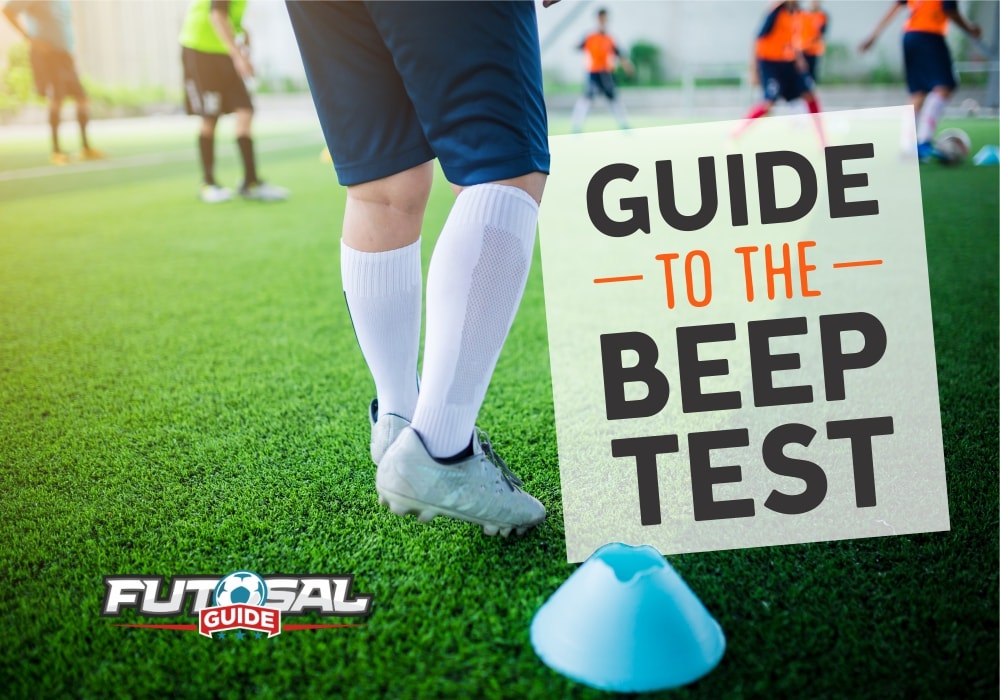You may have heard of the Beep test, Shuttle run or the Bleep test, It was first introduced in 1982 and developed from the University Of Montreal Track Test. This test was conducted around 400m running track and the pace was increased every 2 minutes by audio cues.
DOWNLOAD THE BEEP TEST AUDIO FILE HERE.
The Beep Test evolved from this by reducing the area required and making it possible for the test to be conducted indoors (this allows environmental conditions to be controlled).
The original test article by Legar and Lambert described a protocol of stages every 2 minutes, later that was reduced to the 1-minute stages we go by today.
The Beep Test is a 20m multistage fitness test. It is commonly used for maximal running aerobic fitness assessment as you can see how quickly your body is able to recover after running and how many stages you are able to complete.
It is very popular due to its ability to test a large number of candidates with minimal equipment. This is an introduction, guide and how to prepare for a Beep Test.
Why The Beep Test?
The Beep Test is actually great for measuring the 3 energy systems, as it combines each of them into a single assessment. Your three energy systems are:
- Anaerobic Alactic – This energy system is most commonly used by sprinters. It is explosive in nature and packed full of power, however, it is short in duration and extremely fast to fatigue.
- Anaerobic Glycolytic – This energy system is a combination of power and efficiency. It allows you to have had a sustained amount of power while holding for a longer duration than a sprint, think a mile run.
- Aerobic – This system is for marathon and cross country runners. It preserves as much energy as possible to sustain a long duration of running. This energy system tends to lack in power to preserve for distance.
Not only can you target the 3 energy systems, but it is also relatively easy to assess a large group and inexpensive.
The Beep Test also allows participants to gain an understanding of pace. This is particularly important in children developing their sense of pace, as well as the runner who often find themselves with energy to burn at the end of a race.
This allows them to get a better understanding of their abilities so they can finish with no energy in the tank and it all on the track. It minimizes the embarrassment of the slowest person to finish or individual not finishing at all, which is great for kids in school.
Equipment
When it comes to equipment for the Beep Test there are a few basic items that are required. These include:
- Flat, non-slip surface
- Marking Cones
- 20m Measuring Tape
- Beep Test Audio
- Music player/speakers
- Recording sheets
Pre-Test
Before the session begins it is best to explain the test to those who are going to be involved. Many of the Beep Test audios do have an explanation prior to commencing the test. This is usually to ensure that everyone understands what is required of them and what they are going to be participating in.
Prior to the test being taken any health risks should be screened for. You should also obtain written consent from a medical practitioner to ensure those participating are healthy enough to do so without any potential risks.
Recording sheets should have any basic information filled in. This includes date, age, height, weight, gender, test conditions (ie weather and running surface) etc. Taking down all this information allows correct analysis of the test and comparison points for prior and future testing.
Measure and mark out the course. Utilize the cones to create two lines 20m apart. Use enough cones so the lines are clearly distinguishable. Remember to take your time measuring out the 20m distance between the cones.
This test can be performed indoors or outdoors, as long as the surface is flat and not slippery. Be observant especially if outside if there are any hazards and discrepancies in the surfaces.
Remember to always have a first aid kit on hand and an emergency procedure in place just in case there is an accident.
Depending on the candidates who are participating in the Beep Test and the reason for participation, it may be of use to utilize a heart rate and blood pressure measurement.
Take down these measurements prior to testing and then immediately after testing. This can tell you if your contender has actually ‘maxed out’.
Did you know? The Guinness World Record for the largest Beep Test is held by RAF Honington where over 586 men and women took part!
Prepare Candidates
A candidate completing the test can be of any age and size, they are just required to have some sort of fitness to prevent any injury or health risks. It is great for students, sports teams, individuals, and a variety of athletes.
Prior to the test commencing you should get any of your athletes participating in the test to remove any restrictive jewelry.
This includes bracelets, watches, long earrings – anything that has the potential of causing discomfort, restriction or could get caught. You want your athletes to be as safe as possible with minimal risks.
Allow contenders to warm up adequately before commencing the Beep Test. Warm-ups prevent possible injury, muscle strain and damage to the body, especially when it is about to undergo testing.
Test Preparation
Leading up to the test any athlete running in the session should ensure their body is physically primed and ready to perform to their maximal potential. The ability to perform at your maximum performance is more likely if your nutritional and physical at in top shape.
Nutrition
24hrs prior to the test
In this timeframe, you should consume a high carbohydrate diet. This includes items such as pasta, potatoes, cereals etc. You should also avoid any consumption of alcohol or tobacco substances as these can increase heart rate, blood pressure and affect your overall physical health.
Don’t forget the water either, you need that to hydrate your body and flush out any toxins.
12hrs prior to the test
Fluids are vital when you are going to be pushing your body to its limits. You need to be fully hydrated, especially in warmer conditions. For the 12hrs prior to the test make sure you are drinking water regularly.
Day of test
You need to be well nourished on the day of your test. Be sure to have a good breakfast. It is strongly advised to have consumed something 4 hours leading up to the test.
Don’t have anything heavy 2 hours before as it may make you ill while running and prevent you from doing your best.
You also need to avoid caffeinated products. These include:
- Coffee
- Coca-Cola
- Tea
Any product with caffeine in it can increase your heart rate and blood pressure. You don’t want this especially when you are going to be increasing it yourself from the exercise in the test.
Remember to keep topping your body up with fluids by drinking lots of water before testing begins.
Physical Condition
Please remember that the beep test does require you to have some physical fitness to participate.
The 24hr leading up to your Beep Test you should avoid strenuous and heavy activities and/or exercise, This prevents any pulling or damage to your body, particularly your muscles.
Day of test
Avoid any additional exercise prior to the test and probably afterward as well. Not exercising before the test allows your body to keep its energy and reserves for the test, allowing you to get your most accurate test result.
Exercising afterward could possibly strain your body too much and cause an injury and you don’t want that.
Wear the appropriate attire for the test. Usually, this includes shorts or track pants with a shirt, singlet or sports top depending on your preferences.
You should also wear non-slip athletic footwear. Using the appropriate footwear can prevent damages to your ankles, knees, and feet. Ensure your footwear is secured and fastened correctly and tuck your laces in to avoid tripping.
You should not participate in the test is you are suffering from an injury or illness that could possibly worsen as a result of taking part in the test. If you are not in good general health, pass on the Beep Test this time – your health and safety is more important.
Remember to warm up prior to beginning the test. A good stretching routine is advised. All participants should also take part in a cool down after finishing the test.
This can be a slow jog or walk, followed by some stretching. Do not just go and sit or lay down after the test as it can cause your muscles to ache tremendously.
Procedure
The Beep Test is continuous running between two lines that are marked out by cones. These lines are 20m apart in distance. Those participating in the test begin behind one of the two lines and face towards the other line opposite them. The recording that is played will then instruct the participants when to begin.
The contenders are to run between the two lines and turn when signaled by the beeps on the recording. The initial pace is quite slow, often a walking speed and will slowly increase every minute. Once a minute is up there will be a sound heard to signify the increase in speed and the beeps will be closer together. This will continue on for each minute – each minute is a level or stage of the beep test.
If those participating in the test reach the line before the beep sounds, they have to wait until the beep is heard to continue to the other line. As the participants progress through the stages they may not be able to keep up with the beeps.
If they are unable to reach the line before the beep sounds they are to be given a warning and continue to run to the line and then turn and try to catch up with the pace of the beeps within 2 more beeps.
If they are unable to catch up then they have reached their max out and should cease to continue the test.
Utilizing heart rate and blood pressure measurements ensures each competitor is pushing themselves. This also allows you to compare their beginning measurements to their maximum measurements allowing you the chance to determine if they have fully pushed themselves to the max.
Scoring
The score is the level and the number of shuttles (20m) they completed successfully before they were unable to keep up with the beeps. You need to record the level and shuttle number that was completed successfully, not the one the participant stopped at.
Reliability
The reliability of this test varies depending on how strictly you conduct the test, the practice allows and many other variables, including physical health and diet. You need to control as many factors as possible to safeguard the reliability of the test conducted.
Here is a rough list to give you an idea of factors that may affect performance:
- Health
- Diet
- Running surface
- Weather conditions
- Equipment use ie variation of Beep Test
- Practice allowed
- Warm up
- Clothing
- Running efficiency
- Turning technique
- Motivation and social dynamics
- Motor skills and cognitive ability (especially in children)
- Familiarization with the test and instructions
Pros and Cons
Pros
- Test a large group
- Minimal Costs
- Continues to maximum effort unlike other endurance capacity tests
Cons
- Practice and motivation can influence scores
- Scoring can be subjective
- Environmental conditions can affect results
- Can be unreliable depending on how the test is controlled
Variations
The test is known by many names. However, each name can also have a slight difference in the version of the test. Be wary when comparing results of completed tests and comparing results to norms.
The most common version of the test starts at an initial running velocity of 8.5km/hr. This is slowly increased each minute (level) by 0.5km/hr. Another version of the test starts at 8.0km/hr. Then level 2 jumps to 9.0km/hr and from there afterward increases in increments of 0.5km/hr each minute.
Beep Test Ratings
A Beep Test becomes pretty pointless unless you are able to accurately analyze and interpret the information that is provided to you during the completion of the test. Understanding the results is vital to modify training and fitness correctly, especially for high-class athletes.
The images below indicate the expected outcomes for each gender and age group. This allows you to accurately rate your beep test results.
The scores listed in the images indicate the level and the number of shuttles completed.
The information in the tables are read by:
Level / Shuttle Number


*These tables are an indication of general guidelines. Depending on the requirements of the candidates being tests the results may need to be altered.
Example:
A contender who scores an average rating may be excellent for their requirements, while a rating that is good may be classified as a fair rating instead due to their requirements.
The Beep Test is a great assessment of endurance and overall fitness. Remember not to be discouraged by your first result, or even third result – take the time to improve your rating and you will be able to notice a difference. Run the test as smoothly and efficiently as possible and try to standardize the tests as much as possible. See where you max out at!
Related Questions
What is the highest level in the Beep Test?The recording for Beep Tests varies, however, the highest level is typically 25.
How many kilometers will I cover in a Beep Test?This is dependent upon the level and number of shuttles you complete successfully. To give you an idea here are a few levels with the equivalent km ran.
- Level 1 – You have run 140m
- Level 5 – You have run 820m total
- Level 10 – You have run 1,880m total
- Level 15 – You have run 3,140m total
- Level 20 – You have run 4,620m total












